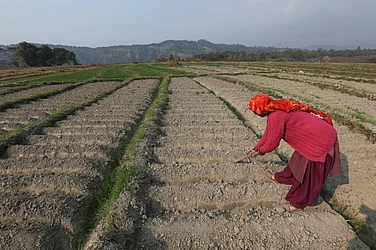I still remember the cold and breezy morning of January 26, 2001. India was celebrating its 51st Republic Day. For me, it was a relaxed day, a holiday. I settled on the sofa with my coffee and sandwich and switched on the television to watch the Republic Day parade, something that I had been doing religiously from the time I was a five-year-old child. While I lazily flipped through the pages of the newspaper, something on TV caught my attention—the word ‘Bhuj’ flashed in bold. There had been a massive earthquake in Kutch, Gujarat at 8:46 am. For me, at first, it was just breaking news. But within minutes, when the visuals started coming in, I was shocked and stunned.
It was heart-breaking to see visuals of entire buildings collapse like a pack of cards, concrete turned into rubble, mangled human bodies lying scattered under and near the debris, children and women howling, calling out to their loved ones, not knowing if they are alive. Within a fraction of seconds, Bhuj, once a prosperous town in Gujarat’s Kutch region, had turned into a mass grave. It was emotionally crushing to see 400 school children, participating in the Republic Day parade, were buried under the rubble. While they were marching to the tune of the national anthem, houses on both sides of the street collapsed, crushing the innocent and hapless children. I could not watch anymore.
I read the next day that most hospitals were completely destroyed. The survivors, many of whom were buried under the rubble for hours, were rushed to makeshift clinics. Poorly equipped and short in number health workers struggled to keep them alive.
‘Nature Unleashes Armageddon’, screamed the headline of a newspaper the next morning. It was powerful. But how could a few words grasp the long-lasting pain an individual, a family, a community and an entire state suffered on that unfortunate day? What separated me from them was sheer luck.

I watched the chaos, devastation and destruction on a TV screen, yet my body went numb. How does one prepare for a sudden disaster of this scale, how does one deal with it? Earthquakes don’t kill people, buildings do, they say. For those in Bhuj who survived the earthquake only to dig mass graves and bury their loved ones en masse, the morning of January 26, 2001 was a life-altering one.
Just seven years ago, in 1993, a massive earthquake had struck the Latur-Osmanabad region in Maharashtra. It was also a case of a happy occasion turned into a macabre scene of death and destruction. Sleeping after the festival of Ganesh Chaturthi, little did thousands of residents of Latur know that they would never wake up. The earth shook vigorously in the middle of the night, destroying as many as 50 villages and consuming almost 10,000 lives.
It took me a while but I was able to erase those horrifying visuals of the Bhuj earthquake from my mind. But, not for long. Just three years later, I witnessed something more devastating—in terms of scale, in destruction, in loss of life and the sheer fury of nature. It was a humbling and frightening experience to look at the gigantic, white foamy waves of furious waters of the Indian Ocean strike the coastline of several countries, including the southern tip of India with unimaginable force. It was Boxing Day in 2004, a day after Christmas meant for celebrations. As footage after footage of the tsunami flashed on TV, I got a sense of the magnitude of the tragedy. An earthquake under the sea had turned it rogue. And it was ferociously consuming all that stood in its path. This was the first time I heard the word tsunami, let alone understand its meaning or magnitude. Till date, the word is etched in my mind as a synonym for something that shakes up lives, often irreversibly. Over 2.30 lakh people perished due to the tsunami. Around 10,000 of them belonged to India.
This was a wave of terror—just like the ‘landslide of terror,’ which struck a small village in Uttar Pradesh’s (now Uttarakhand) Pithoragarh district. The name of the village Malpa became synonymous with the catastrophic landslide that almost wiped it out on August 18, 1998. Among the 200 dead were pilgrims en route to the Kailash Mansarovar yatra. I remember the name of only one of them—noted dancer Protima Bedi. The others remain faceless and nameless for me, reduced to statistics of tragedy. Even the thought of those decomposing bodies being rescued by paramilitary forces from Malpa few days after the incident, causes my stomach to churn. What a tragic and sudden way to perish. Almost a sign by Mother Earth that she cannot take any more exploitation by us.
For many, Uttarakhand, with its mesmerising Himalayan landscape and free-flowing sacred rivers, offers an escape from the drudgery of city life and the dusty plains. But sometimes it brings with it plenty of peril. In June 2013, flash floods caused by torrential rains wrecked havoc in the hilly state, killing over 6,000 people, both locals and tourists, and destroying thousands of dwellings. It was appalling to watch the rampaging rivers wipe out everything that came in their path. It was a terrifying to watch on television the same bridges that I had taken during my trip to the Mandakini Valley four years before shattered into two. The tragedy had hit home.
The incident also made me conscious of the fragility of our environment, especially in hilly states like Uttarakhand, which, in 2016, just three years after the devastating floods, suffered from a summer of damaging forest fires. The bright golden flame flashed on screen, some even engulfing the tallest of trees, reminded me of a funeral pyre. Although the forest fire did not cause that many human casualties, it burnt down thousands of hectares of forest land and trees.

I have never travelled to Odisha although I enjoy looking at images of its vibrant culture and expansive coastline. But, in 1999, when the state was hit by a ‘Super Cyclone’, I was overwhelmed. The power of the sea winds roaring at hapless people, many of them poor fisher folk out with their boats and fishing nets, was on display. Houses were flattened, trees were uprooted and civic infrastructure was damaged. Can you imagine winds travelling towards your humble dwelling at the speed of more than 250 kmph? I couldn’t, till I watched footage after footage of the destruction. It was like a punch in the gut.
Those who witnessed Cyclone Amphan hit the coast of West Bengal and Odisha in 2020 perhaps got a glimpse of the 1999 Odisha cyclone. Amphan was the first Super Cyclonic Storm over the turbulent Bay of Bengal following the 1999 storm. The storm made its impact across the Sundarbans with a maximum sustained wind speed of 155–165 kmph gusting to 185 kmph. The sight of tall palm trees swaying to the tunes of furious winds was a reminder of its force. Buses were cracked open by trees that fell on them, while several humans perished to electrocution, one of my biggest fears during the monsoons. A storm just doesn’t toss you to death, it also exploits the deficiencies in our infrastructure, as a result of which the scale of jeopardy goes up.
While cyclones are an expected phenomenon along the coast, some events catch you by surprise—like the drowning of the beautiful Kashmir valley in 2014. Incessant rains in September that year caused massive floods in the conflict-ridden state, submerging vast tracts of Srinagar, Baramulla, Kulgam, Pulwawa and other areas. In Srinagar, the embankments of the Jhelum breached at several locations. The famous shikara boats used by tourists to enjoy ‘paradise’ on the Dal Lake, were now being used to rescue stranded people and provide them with rations. It was a nightmare to watch the visuals of a submerged Srinagar, appearing like wooden chunks drowning in a big bowl of mud soup. It was as if the rain gods had shifted attention from the political conflict in the state to something more urgent, its fragile topography and uncontrolled urbanisation.
Four years before the calamity in Kashmir valley, its geographical cousin Ladakh suffered similar devastation. Flash floods due to a cloud burst created rivers of destruction in the picturesque region. The sudden downpour—14 inches of rain in just two hours in the middle of the night—killed over 230 people.
Floods have been the most destructive and recurrent form of natural hazard over the years. In Assam, they are an annual affair. Entire rural villages are drowned by the swollen Brahmaputra river. Families use small boats to paddle to safety and salvage whatever little they can to start over again, only to face a similar threat the following year. In 2020, Assam received considerably high rainfall, impacting not only humans, but also its rich wildlife. Several rare, one-horned rhinos died. Each year, it is painful to see thousands of people survive in relief camps following the displacement caused by floods. Lives get reduced to survival and grit.
Talking of survival and resilience, there is no better example than the biggest megapolis in the country, the ‘city of dreams’ and big money, Mumbai, which is prone to flooding. On July 26, 2005 the city faced its worst moment as it came to a standstill. Heavy rains—said to measure 94 cm, a 100-year-high, in a span of 24 hours—battered the city. Many parts of the city were flooded, its roads and famed local railway lines went underwater and the airport was waterlogged. People were forced to wade through chest-deep water. It was after the Mumbai floods of 2005 that the National Disaster Management Authority decided to delink urban floods from floods and listed ‘urban flooding’ as a separate disaster to study and strategise it differently. After all these years, we must ask, have they?
From Latur to Ladakh, Malpa to Mumbai, our lives are always on tenterhooks. A natural hazard plays no favourites. It spares none.
(This appeared in the print edition as "The Persistence of Memory")
(As imagined by Omar Rashid)


























